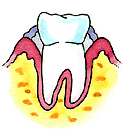
What is Gum Disease?
Gum disease, also known as periodontal disease (periodontal means ‘around the tooth’), is a serious progressive inflammatory disease of the gingival, connective tissue and bone around the teeth. Gum disease is a chronic bacterial infection that is characterized by loss of attachment between the teeth and the supporting bone, due to destruction of the periodontal ligaments and jawbone loss. If it is left untreated, it can lead to tooth loss. Periodontal disease is the number one cause of tooth loss after the age of 30 and it is believed to affect around 80% of the population above 30.
Gum Disease information
Gum Disease and your Health
Several studies suggest that gum disease can seriously affect your general health. The strongest and most evidenced mouth-body health link is the one between gum disease and heart disease. Gum health problems have proved to increase the risk of heart attack or stroke. Other health condition links include gum disease and diabetes, respiratory diseases and premature, low birth weight babies.
Types and Stages of Gum Disease
The main types of gum disease are: Gingivitis (the mild form of the disease) and Periodontitis (the most severe type). Several other sub-types such as pregnancy gingivitis, pericoronitis, and Acute Necrotizing Ulcerative Gingivitis (ANUG) are also distinguished based on the special characteristics of the condition.
The biggest danger of periodontal diseases is that most of the patients are unaware of their problem, until it has reached the advanced stages of gum disease.
Dental Plaque / Dental Calculus
Dental Plaque is an almost invisible film of bacteria that accumulates on our teeth and gums (especially in the spaces between the teeth and along the gum line).
Dental Calculus (also known as dental tartar) is a yellowish or brown layer of mineral deposits on the teeth surface created by hardened dental plaque. Tartar promotes further accumulation of dental plaque, and causes inflammation of gums, gum recession and gum disease.
Causes and Symptoms of Gum Disease
The main cause of gum disease is considered to be poor oral hygiene that allows the growth of dental plaque bacteria and the accumulation of dental calculus. Several other risk factors also contribute in developing periodontal diseases.
The condition may be completely reversible if the symptoms of gum disease are detected before the disease has progressed from gingivitis to periodontitis. It is very important to recognize the early symptoms of gum disease and seek treatment before it causes significant damage to your gums and bone.
Gum Disease Prevention
Periodontists are the dental experts to prevent, diagnose and treat diseases of the periodontium. A thorough periodontal examination is necessary to assess the health of gums and teeth. The depth of the periodontal pockets around teeth is the main indicator for the progression of gum disease, and for the level of destruction of periodontal tissues. The process, called periodontal probing, helps the periodontist to make a precise diagnosis, evaluating the severity of periodontal disease cases and developing the adequate treatment plan.
Prevention of gum disease can be achieved by eliminating the causative factors that lead to gum infections and periodontal disease, with most important the control of dental plaque by maintaining good oral hygiene.
Gum Disease Treatments
Almost 90% of the population will need gum disease treatment some time in their life. The effective treatment of gum disease is extremely important for the preservation of teeth and maintaining good oral health and proper mouth functionality. Several types of periodontal disease treatments can be performed depending on the type of periodontal disease and how far the condition has progressed.
Improving your daily oral hygiene in combination with a deep cleaning (dental scaling and root planing) from your dentist are usually enough for the treatment of gingivitis. The use of antibiotics against gum disease can help to fight the bacterial infection by inhibiting the bacterial growth.
Unlike gingivitis where the condition can be fully treated with simple non-surgical treatments, in the advanced stages of gum disease, periodontitis treatments that involve gum surgery are necessary to restore some of the damage caused to periodontal tissues and to create a more maintainable periodontal environment to prevent the recurrence of the disease. Following your dentist’s instructions after gum surgery is important for preventing post-surgery complications.
Several types of gum surgery may be required as part of a periodontal disease treatment plan. These include:

